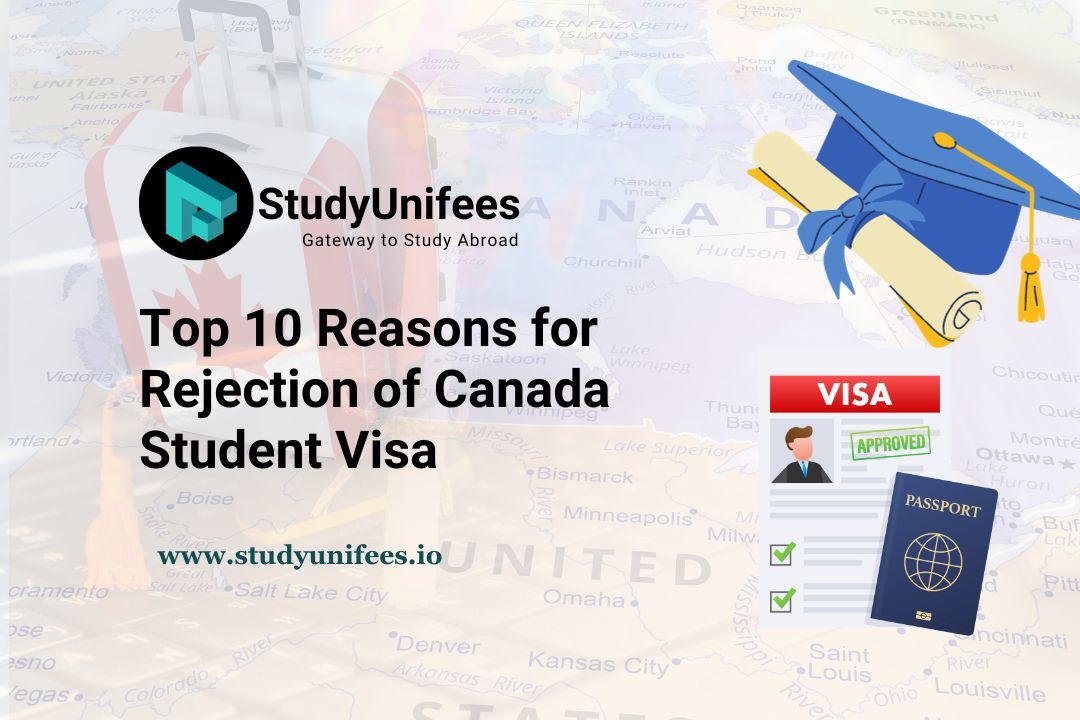Embarking on a journey of education in Canada is a dream for many international students. However, the pathway to obtaining a Canada student visa is intricate, and applicants often find themselves facing unexpected hurdles. In this comprehensive guide, we will explore the nuanced process of acquiring a Canada student visa, distinguish between the Student Direct Stream and Regular Study Permit, outline the profile of a successful candidate, and shed light on the top 10 reasons that could lead to the rejection of a Canada student visa application.
The Journey to a Canada Student Visa: Obtaining a Canada student visa is a multi-step process that requires careful planning and adherence to specific guidelines. The process typically involves the following key steps:
- Acceptance into a Designated Learning Institution (DLI): Before applying for a Canada student visa, prospective students must secure admission to a DLI, a crucial prerequisite for the visa application.
- Gather the Necessary Documents: Applicants must compile a comprehensive set of documents, including an acceptance letter from the DLI, proof of financial capacity, language proficiency test results, and other supporting documents.
- Create a GCKey Account: As part of the online application process, applicants are required to create a GCKey account to access the Canadian government’s online services.
- Submit the Online Application: Using the Immigration, Refugees, and Citizenship Canada (IRCC) website, applicants must submit their online visa application, paying careful attention to accuracy and completeness.
- Biometrics and Medical Examination: Applicants may be required to undergo biometric data collection and a medical examination as part of the visa application process.
- Wait for Processing: After submission, applications undergo a thorough review process, and applicants must patiently await a decision.
Student Direct Stream vs. Regular Study Permit: Understanding the distinction between the Student Direct Stream (SDS) and Regular Study Permit is crucial for prospective international students.
- Student Direct Stream (SDS): The SDS is an expedited processing system available to students from select countries. It aims to streamline the visa application process, offering faster turnaround times. To be eligible for SDS, applicants must meet specific criteria, including language proficiency and financial requirements.
- Regular Study Permit: The Regular Study Permit is the standard application process for obtaining a Canada student visa. While it may take longer for processing compared to SDS, it remains a viable option for students who do not meet the criteria for the expedited stream.
Profile of a Successful Candidate: A successful candidate for a Canada student visa often possesses the following attributes:
- Admission to a Designated Learning Institution (DLI): Successful candidates have secured admission to a recognized DLI, providing assurance of their commitment to pursuing quality education.
- Sufficient Financial Resources: Demonstrating the ability to cover tuition fees, living expenses, and other related costs is vital. This may involve presenting bank statements, scholarship details, or a letter of financial support.
- Proficiency in English or French: Meeting language proficiency requirements, typically through tests like IELTS or TOEFL, is a key indicator of a candidate’s ability to thrive academically in a Canadian institution.
- Clear Intent and Purpose: A compelling Statement of Purpose outlining the candidate’s educational and career goals, as well as their intent to return to their home country after studies, strengthens their application.
- Adherence to Visa Regulations: Candidates who meticulously follow the visa application guidelines and provide accurate information increase their chances of approval.
Top 10 Reasons for Rejection of Canada Student Visa Applications:
- Insufficient Financial Proof: One of the most common reasons for the rejection of Canada student visa applications is the inability to demonstrate sufficient financial capacity. Visa officers assess an applicant’s ability to cover tuition fees, living expenses, and other associated costs throughout their study period in Canada. Insufficient funds or unclear documentation regarding the source of income can lead to serious doubts about the applicant’s financial stability. To avoid this, it is crucial for applicants to provide comprehensive and accurate financial documents, including bank statements, sponsorship letters, and details about any scholarships or financial aid.
- Lack of Genuine Intent: The Canadian government places a high value on students who genuinely intend to pursue their studies and then return to their home country upon completion. Visa officers closely scrutinize applicants’ statements of purpose and interviews to assess the sincerity of their intentions. Applicants need to articulate a clear educational and career plan, emphasizing how their studies in Canada align with their long-term goals. Failure to convince visa officers of genuine intent can result in rejection.
- Incomplete Documentation: Incomplete or missing documents can be a significant stumbling block in the visa application process. Visa officers expect a comprehensive submission of all required documents, and any omission can lead to delays or outright rejection. Applicants should carefully review the document checklist provided by the Canadian government and ensure that each item is accurately completed. This includes academic transcripts, letters of acceptance from the DLI, language proficiency test results, and any other documentation specified in the application guidelines.
- Low Language Proficiency: Meeting the language proficiency requirements is paramount for visa approval. Canada, being a bilingual country, accepts proficiency in English or French. Inadequate scores in language proficiency tests, such as IELTS or TOEFL, may lead to rejection. Applicants must thoroughly prepare for these tests and aim to surpass the minimum requirements set by the DLI to strengthen their case. Strong language skills not only enhance the likelihood of visa approval but also contribute to academic success in a Canadian institution.
- Criminal Record: Applicants with a criminal record or a history of involvement in illegal activities may face challenges in obtaining a Canada student visa. Visa officers prioritize the safety and security of Canadian society, and any perceived threat may result in visa rejection. In such cases, applicants should provide comprehensive information about their criminal record, including evidence of rehabilitation, to mitigate concerns and improve their chances of approval.
- Medical Inadmissibility: Medical examinations are a mandatory part of the visa application process. If an applicant fails to meet the health standards set by the Canadian government or presents a medical condition that poses a risk to public health, their application may be refused. In such instances, applicants should seek professional guidance, provide comprehensive medical documentation, and address concerns raised by the immigration medical officer.
- Unstable Political Situation: Applicants from countries experiencing political instability or conflict may face increased scrutiny during the visa application process. Visa officers assess the potential risks associated with applicants from such regions, taking into consideration the safety and security of the individual as well as the broader Canadian community. It is essential for applicants to provide context to their situation, highlighting their commitment to abide by Canadian laws and emphasizing the temporary nature of their stay for educational purposes.
- Misrepresentation: Providing false information or misrepresenting facts in the application is a serious offense that can result in immediate rejection and may lead to future bans on entering Canada. Applicants should be transparent and honest throughout the application process, ensuring that all information provided is accurate and verifiable. Any discrepancies between the application and supporting documents may raise suspicions and jeopardize the chances of visa approval.
- Academic Ineligibility: Failing to meet the academic requirements set by the chosen DLI is a common reason for visa rejection. Visa officers assess whether applicants possess the necessary educational background to succeed in their chosen program. It is imperative for applicants to carefully review the academic prerequisites of their chosen institution and program, ensuring that they meet or exceed the specified criteria. In cases where academic qualifications are lacking, applicants may consider additional courses or certifications to strengthen their application.
- Overstay History: Individuals with a history of overstaying visas in Canada or other countries may be deemed high-risk, raising concerns about their likelihood to comply with visa regulations. Past violations of immigration laws can significantly impact the decision-making process. Applicants with a history of overstays should provide a detailed explanation of the circumstances, evidence of compliance with immigration laws since the incident, and a robust plan to adhere to Canadian visa regulations.
Conclusion: Navigating the process of obtaining a Canada student visa requires a meticulous approach and a thorough understanding of the specific requirements. By familiarizing themselves with the nuances of the application process, prospective international students can address potential pitfalls and enhance their chances of securing a coveted Canada student visa. Whether choosing the Student Direct Stream or the Regular Study Permit, applicants must carefully consider the profile of a successful candidate and diligently address the top 10 reasons for rejection to pave the way for a successful academic journey in Canada.


